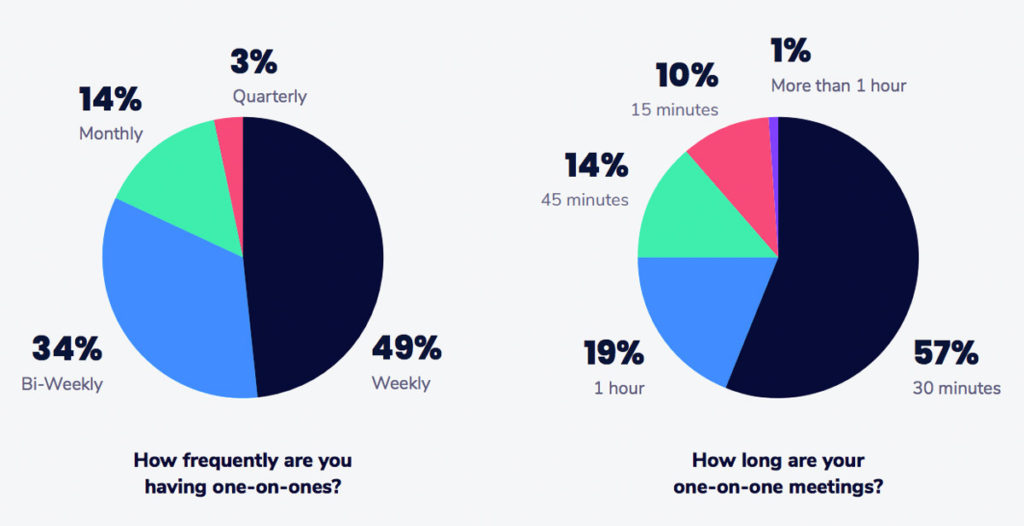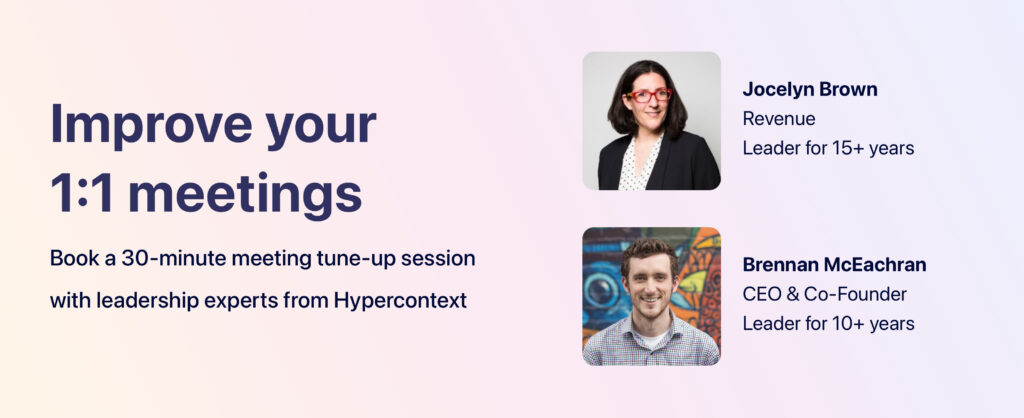How to give employee recognition in one-on-one meetings
When building a recognition-rich culture, a great place to start is during one-on-one meetings. Read on about the benefits of recognition and how to effectively share it in one-on-one meetings.
 Connie Du
Connie Du
Warning: Undefined array key "category" in /www/hypercontext_216/public/wp-content/themes/Soapbox/hype-files/sections/article/content.php on line 10
One-on-one meetings are great for regular check-ins on projects, timely feedback, and communication transparency. But here’s an aspect of one-on-ones that many teams forget about: It’s a great opportunity to tell someone they did a great job.
Recognizing team members for their contributions has a lot of upsides. In addition to increased productivity, morale, and retention, being appreciated just makes people feel good about themselves and the work they do.
So, it’s no surprise that employee recognition is closely correlated with employee engagement. In fact, in Bonusly’s 2019 Employee Engagement and Modern Workplace Report, 84% of highly engaged employees were recognized the last time they went above and beyond, compared to only 25% of highly disengaged employees.
84% of highly engaged employees were recognized the last time they went above and beyond, compared to only 25% of highly disengaged employees.
Sounds simple, doesn’t it?
Unfortunately, as easy as it may seem, the majority of employees feel like their manager doesn’t recognize their contributions enough. So this simple act of appreciation can make a bigger difference than you’d anticipate.
Setting aside time for recognition during one-on-ones gives you an opportunity to reinforce the behaviors you want to continue seeing in your team. But, don’t forget that recognition is a two-way street—managers also need recognition to feel purposeful and motivated. On top of that, it’s an excellent opportunity for your team to communicate what they appreciate about you and your management style.
When it comes to employee engagement, motivation, and retention, employee recognition is your best bet. Here are five best practices you should keep in mind the next time you recognize someone during a one-on-one meeting.
A manager’s guide to recognition best practices
To give the most constructive recognition, there are a few recognition best practices you should know. Organizational and cognitive studies show us that the best and most impactful recognition is:
Timely
Memories fade with time, and so does the glow of receiving recognition for your hard work. As weeks go by and your team members’ priorities shift to new projects, a belated “oh, great job on executing last quarter’s content calendar,” doesn’t have the same impact as it would in the moment.
You should aim to make a clear connection between a specific behavior and recognition for it, and that includes giving the feedback soon after an action occurs.
Waiting to recognize a valuable contribution can result in a fading impact of that recognition and lost opportunities to encourage the same kind of positive behavior.
Frequent
Don’t reserve praise for the annual review! Frequent check-ins encourage employee engagement, psychological safety, and are a great space to provide timely and frequent feedback—including recognition for the week’s contributions. 🙌
This makes one-on-ones the perfect space to appreciate your direct reports! In fact, 49% of managers have weekly one-on-ones, and it’s a practice we definitely recommend.

Specific
With regular one-on-ones, you’re in the perfect position to get really specific with your recognition. Discuss why you thought they went above and beyond, how it made you feel, and what impressed you.
Your feedback receiver should understand exactly why they received recognition for a specific behavior—all the easier to do it again and again!
Here are a few examples of specific recognition:
- I was really impressed by your communication style during this difficult project. I know it wasn’t easy, but you kept everyone in the loop and presented objections in an empathetic, timely and thoughtful manner.
- Thanks for taking the initiative to re-evaluate our account spending. You made some excellent recommendations that will help us save money while still hitting our goals. This is a great example of working smarter!
- If you hadn’t volunteered to recalculate our data sets with me, I would have been here all night! Thanks for jumping in immediately when I needed help and brainstorming with me about how to best address the problem. It feels great to know that I can count on you when I’m in a bind.
It’s a bit more thorough than just a thank you, isn’t it?
Inclusive
Inclusive recognition helps foster a sense of equity, belonging, and psychological safety for all employees. Showing employees that not only do they belong, but their opinions do too should be a top priority for leaders. For example, if your organization only allows for top-down recognition, you’re implicitly communicating that feedback from direct reports isn’t valued. Recognition for everyone, from anyone, is important to make employees feel seen, appreciated, and valued.
Understanding how recognition and feedback is shared across all levels of your organization will shed light on whether or not your workplace culture is truly inclusive.
Values-based
Values-based recognition encourages teams to work toward the same vision. When sharing positive or constructive feedback, think about how a contribution lines up with your values.
If your company culture is based on a shared set of values, reinforcing those values through praise should be a deep-rooted habit. And if you decide that appreciating one another and giving recognition is one of those values, make it a habit to always have space in your one-on-ones for dedicated recognition time.
Visible
So you had a great one-on-one—but does your appreciation and recognition for your colleague get communicated outside of your private meeting? It should!
Whether it’s with a shout-outs channel in Slack, during your weekly team meeting, or publicly through a peer recognition platform like Bonusly, there’s no reason why you should keep recognition private.
Recognition is a two-way street
Like we mentioned, recognition should be inclusive. This means that while you recognize your direct reports during one-on-ones, you should also be encouraging them to recognize you!
Everyone should have the opportunity to learn and grow. Asking your direct reports for recognition is a subtle way of understanding the behaviors they value and presents an opportunity for you to grow, too.
This idea goes all the way up the ladder. Even CEOs need recognition! 😉
Similar to how you recognize your direct reports for valued behaviors, you can also encourage your leaders in a similar way. In the act of appreciating certain actions, you’re also communicating the leadership qualities you want to see in your own manager.
For example, you can recognize leaders for:
- Transparent and timely communication
- Tailoring their management style for each individual
- Addressing feedback in a thoughtful way
- Implementing policies that promote employee wellness
- Encouraging flexible work schedules
- Being an empathetic leader
One-on-one meeting questions to encourage recognition
A great way to encourage recognition is by prompting your team with one-on-one questions. I’ve listed out a few below:
- Who is doing a great job on the team right now?
- What do you feel is my biggest strength?
- Who is someone across the organization that really embodies our values?
- What project are you most proud to have contributed to?
- What were your highs and lows from the past week? How can I help?
- How do you prefer to be appreciated?
- Publicly or privately?
- Verbally, in written form, or a different way?
- Do you find recognition from leaders or peers more meaningful? What can I do to make sure your work is recognized by the people you admire?
- Do you feel valued by the company? If not, what can I do to make you feel valued?
Key takeaways
When building a recognition-rich culture, a great place to start is during one-on-one meetings. Alongside benefits like increasing employee engagement, motivation, and productivity, regularly giving recognition to employees is positive reinforcement for doing excellent work and exhibiting company values.
This has an organization-wide impact—especially if you’re disciplined about sharing and publicizing your recognition! When you expose employees to the stream of the great work their team members are doing, they’re inspired to do their absolute best.

Connie Du is on the marketing team at Bonusly and is dedicated to making workdays a little brighter for everyone. ☀️She loves writing, her cats, and a well-placed emoji.
Want to improve how you run one-on-ones? Book a free tune-up with a leadership expert at Hypercontext. 👇

What should you do now
Now that you've read this article, here are some things you should do:
- If communication is a challenge for your team, you should check out our library of meeting agenda templates.
- You should try Spinach to see how it can help you run a high performing org.
- If you found this article helpful, please share it with others on Linkedin or X (Twitter)
